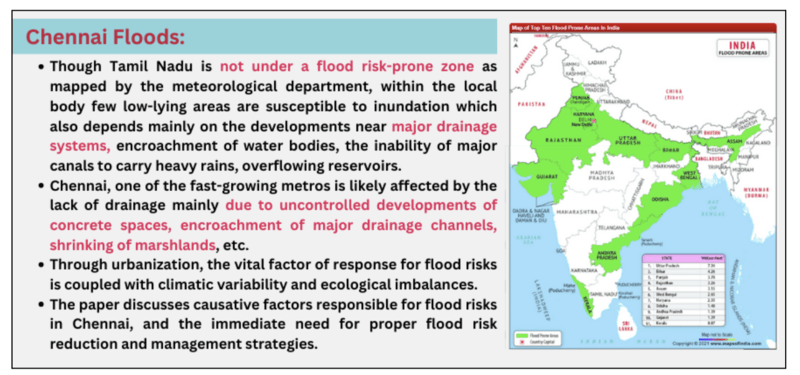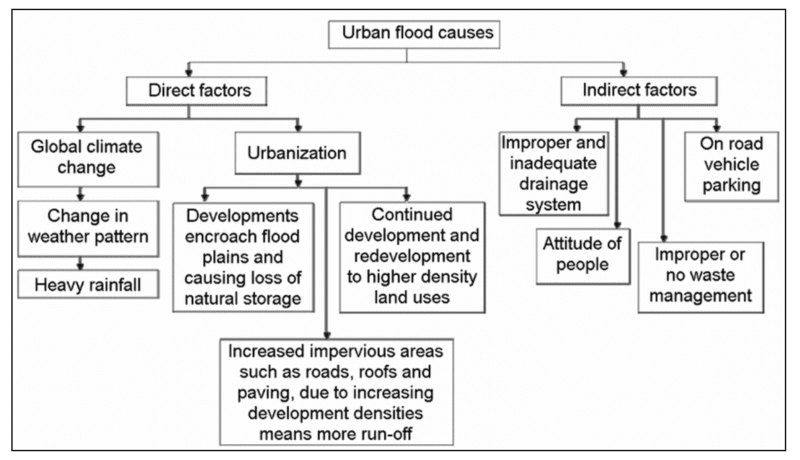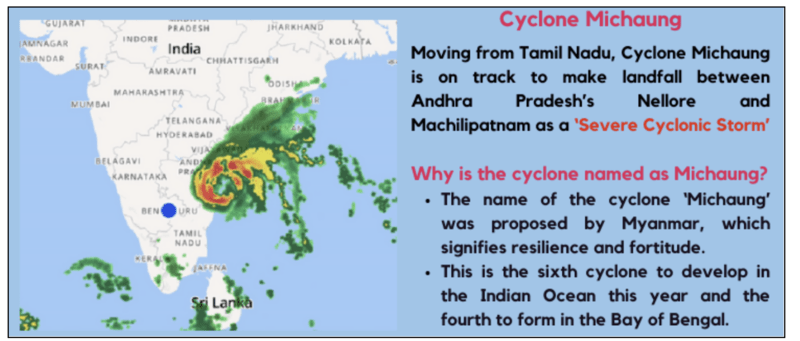The looming threat of urban floods
“We cannot stop natural disasters but we can arm ourselves with knowledge.” - Petra Nemcova
Relevance: GS III (Disaster Management)
- Prelims: Indian Ocean Cyclones and their naming; Sendai Framework;
- Mains: Flood-related disasters; NDMA Guidelines;
Why in the News?
Indian cities are witnessing devastating floods more often due to heavy rainfall, cyclones, etc. Cyclone Michaung has thrown life in Chennai out of gear.

What are the major causes of urban floods in India?
There are both local (direct) and global (indirect) factors for these events.

- Direct Factors: The climate crisis has accentuated these disasters. Rainfall that was spread across the monsoon season often falls in a day or two.
- Climate change and events like strong winds and heavy rains along the coastal areas are constantly rising.
- Rising water levels: They can cause storm surges, which are sudden rises in sea level due to low atmospheric pressure and high winds. Storm surges can inundate low-lying areas and cause coastal flooding.
- River overflow in urban areas can also be caused by factors such as heavy rainfall, snowmelt, cyclones, dams, barrages, or siltation. E.g. Delhi floods.
- Indirect Factors: The infrastructure has not kept up with the pressures of population explosion. Lakes, tanks, and floodplains of rivers have been encroached on, leading to impediments in the drainage of flood waters.
- Most importantly, despite many bad experiences, the government still lacks updates on preventive and mitigation strategies.

Global Scenario:
- Floods due to Climate Change: In September, Mediterranean storm Daniel affected Libya, Greece, and Turkey, with 11,000 persons killed in Libya alone.
- Rising global temperatures are making cyclonic storms frequent — this phenomenon is increasing on India’s west coast. We need to heed the warning.
- Dubai COP28 has just launched the Loss and Damage Fund, meant to help vulnerable countries cope with climate crisis disasters.
Government Initiatives:
- Preventive measures:
- Safety Embankments: Embankments are constructed to create a “safe” area for habitation. Still large populations continue to stay inside the embankment, that is, outside the “safe” areas, at the mercy of the imminent flood.
- Flood Prone Zone: The Rashtriya Barh Ayog (1980) assessed the area of 40 mha in the country lying in 21 States and one Union Territory. Subsequently, a Committee constituted under the Chairman, the Ganga Flood Control Commission (GFCC), identified a total of 39 districts in the country as flood-prone.
- Regional Disaster Preparedness: India has hosted Disaster Management Exercises with BIMSTEC (Bay of Bengal Initiative for Multi-Sectoral Technical and Economic Cooperation) countries that allow NDRF to demonstrate for counterparts from partner states the techniques developed to respond to various disasters.
- Mitigation measures:
- National Disaster Reaction Force (NDRF): India has increasingly mitigated and responded to major types of disasters, including with the establishment of its National Disaster Reaction Force (NDRF), the world’s largest rapid reaction force dedicated to disaster response.
- Foreign Disaster Relief: India’s foreign humanitarian assistance has increasingly included its military assets, primarily deploying naval ships or aircraft to deliver relief. In line with its diplomatic policy of “Neighborhood First,” many of the recipient countries from the region of South and Southeast Asia are covered holistically.
- Sendai Framework: India has adopted the Sendai Framework for Disaster Risk Reduction, the Sustainable Development Goals (2015-2030), and the Paris Agreement on Climate Change, all of which make clear the connections among DRR, Climate Change Adaptation (CCA), and sustainable development.
What must India do to avoid Urban Floods (Way Forward)?
- Infrastructure Upgradation: Indian cities too need to be ready for frequent extreme events, from ensuring better upkeep and expansion of public infrastructure to protecting natural drainage systems to putting disaster management plans in place, the task is cut out.
- Coordination between government agencies:
- Social measure: Some initiatives are necessary that involve creating awareness and imparting knowledge about floods among the society and entities like local communities, officials, media, NGOs, etc.
- Timely regulation: There is a need for the government to timely evacuate people and movable assets to safer places. Regulatory measure that restricts or regulates the use of land in flood-prone areas based on their vulnerability and suitability.
- The National Disaster Management Authority (NDMA) has issued guidelines for floodplain zoning in India that classify the land into four zones: free, regulated, restricted, and prohibited.
- This also promotes the conservation and restoration of natural flood buffers such as wetlands and forests.
- Nature-based solutions:
- Wetlands act as natural buffers against flooding by absorbing and storing water, reducing peak flows, and filtering pollutants. Restoring degraded wetlands can provide multiple benefits such as improving water quality, enhancing biodiversity, and providing recreational opportunities.
BEYOND EDITORIAL:

How are cyclones named?
- The World Meteorological Organization (WMO) and member countries of the United Nations Economic and Social Commission (ESCAP) are responsible for naming each tropical cyclone.
- The names of cyclones depend on the regional rules.
- In the Atlantic and the Southern Hemisphere (Indian Ocean and South Pacific), tropical cyclones receive names in alphabetical order, and women's and men's names are alternated.
- In the Northern Indian Ocean, nations are recently utilizing a new method for naming tropical cyclones in 2000; the names are listed alphabetically by country and are gender-neutral.
Mains PYQ
Q. Major cities in India are becoming vulnerable to flood conditions. Discuss. (UPSC 2016)
Q. Discuss the recent measures initiated in disaster management by the Government of India departing from the earlier reactive approach. (UPSC 2020)

